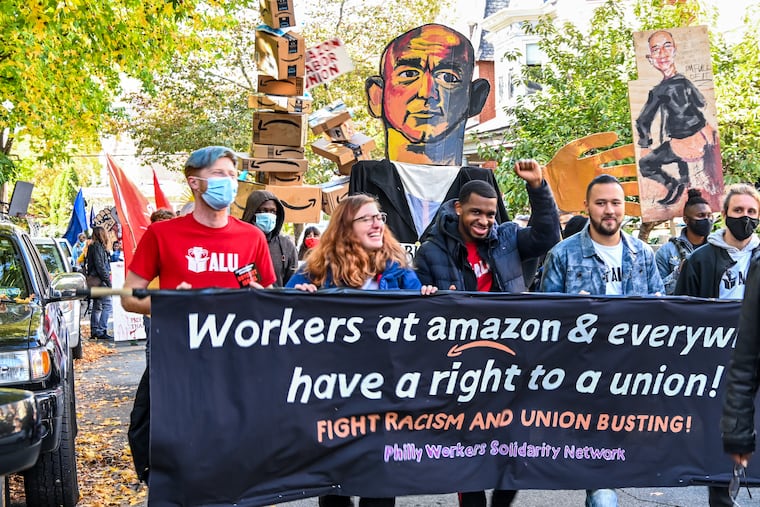Peoplehood Parade and its giant puppets are back in West Philly this weekend
The Peoplehood Parade has been infusing Philly’s resistance and activist movements with joy and coalition-building, quickly becoming a staple of West Philly culture.

For more than two decades, the Peoplehood Parade has been infusing Philly’s resistance and activist movements with joy and coalition-building, quickly becoming a staple of West Philly culture. And after two years of setbacks — the start of COVID-19 in 2020 and flooding caused by last year’s Hurricane Ida — Peoplehood is ready for its next celebration this Saturday, Oct. 15.
“Spiral Q is all about using art for advocacy and awareness — working with activists, supporting direct actions [with] street theater and giant puppets and props to really magnify and amplify the messages of the activists who are literally fighting for our lives, our safety, our spaces,” said Jennifer Turnbull, codirector of Spiral Q, the nonprofit that organizes the Peoplehood Parade.
On Saturday, rhythmic beats of dozens of drums will echo through the streets of West Philadelphia, leading the way for a group of dancers walking and performing. At past parades, giant puppets towered over the dancers, who were holding props like mailboxes to encourage voting, stacks of Amazon boxes to support Amazon workers unionizing, raised fists with Black Lives Matter written on them. The Peoplehood Parade is colorful, celebratory, and passionate — and it’s uniquely Philly.
By raising awareness about various causes such as immigrant rights and supporting community gardens, creating a space for intersectionality and providing an outlet for self-care and joy, Peoplehood is a particularly momentous event for Philadelphia’s vibrant activist community. As the activists come together to create their art, they’re presented with a few prompts to inspire their work.
“What are the things that push you down that are often systemic? What does it mean to create symbols of what healthy community looks like?” said Liza Goodell, the other codirector of Spiral Q. “It’s a productive way to talk about all these issues in another way.”
For Nathaniel Miller, the Peoplehood Parade was always one of his favorite days as a resident of West Philly. So when he and other members of Philly BDS (Boycott, Divestment, Sanction) were presented with the opportunity to amplify their activism for Palestinian human rights through the parade about a decade ago, they jumped on it.
The group built a massive version of Handala, a cartoon of the back of a 10-year-old Palestinian boy with his hands behind his back. The cartoon, created in 1969 by political cartoonist Naji al-Ali, symbolizes the age of the artist when he was expelled from Palestine in 1948, and quickly became a timeless symbol for the Palestinian cause.
“The power for me is the community aspect.”
“It’s really easy for people to get into our silos, and we’re not doing things that are necessarily fun and engaging — but I think that’s an important part of organizing,” Miller said. “So people are meeting, building things together. The parade is a fun, community event — very exciting and celebratory, but still speaking truth to power.”
Jasmine Rivera, coordinator of the Shut Down Berks Coalition advocating to close the U.S. Immigration and Customs Enforcement (ICE) detention center in Berks County, has been collaborating with Spiral Q for about five years. Four years ago, Rivera and other activists in the coalition built giant puppets of Gov. Tom Wolf, Lt. Gov. John Fetterman, and Teresa Miller, former secretary of the state Human Services Department, along with a mother and her baby. The coalition demanded they issue a policy that would remove families from ICE detention centers.
Rivera, who is a long-standing activist, emphasized that creating props is an important strategy in resistance movements. After one year’s Peoplehood Parade, Shut Down Berks Coalition took its giant puppets of Wolf, Fetterman, and Miller and did a demonstration on the Capitol steps in Harrisburg.
But most important, for all the activists involved in the Peoplehood Parade, it’s about bringing joy to the people who fight against systemic injustices — fulfilling but sometimes depressing work that can lead to severe burnout.
“The power for me is the community aspect,” said Rivera. “The power for me is the therapeutic joy one gets from creating art and making something with your hands, seeing the tangible results. The power of coming together, cross-collaborating when it comes to creating art, having fun parading through a neighborhood — that’s powerful in and of itself.”